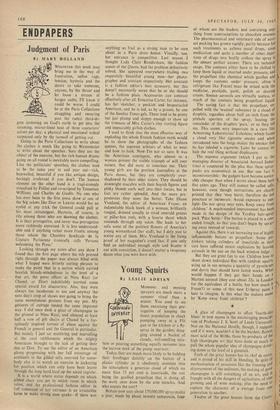ENDPAPERS
Judgment of Paris
By. MARY HOLLAND Going to the Paris Collections to write about the clothes is much like going to Westminster to write about the speeches. Sure they are the object of the exercise, but the rich human drama going on all round is inevitably more compelling. Like the politicians' speeches, the clothes tend to be the same year in and year out—rich, bejewelled, beautiful if you like antique design, boringly irrelevant if you don't. The human element on the other hand is a tragi-cornedy visualised by Fellini and co-scripted by Tennessee Williams and Charles de Gaulle. No one who has ever been to the first press show at one of the big salons like Dior or Lanvin would bat an eyelid at any trick the General could pull at his most intransigent. Hysteria, of course, is rife among those who are showing the clothes. It is their prerogative, and never was prerogative more ruthlessly exercised. It is less understand- able and if anything rather more frantic among those whom the Chambre Syndicale de la Couture Parisienne ironically calls 'Persons welcoming the Press.'
Looking through my notes after any show I found that the first page where the nib pressed right through the paper was always filled with what I hoped were bitterly cutting phrases to make the point that in a nation which carried boorish bloody-mindedness to the level of a fine art, the press officer at Nina Ricci (or Chanel, or Dior) indubitably merited some special award for discourtesy. Alas, they were always too incoherent to use and anyway the. next day's crop of shows was going to bring the same monotonous protests from my pen. My gestures of outrage tended the same impotent way. I did once dash a glass of champagne to the ground at Nina Ricci, and silenced at least half a row of gilt chairs at Chanel by a for- tuitously inspired torrent of abuse against the French in general and the General in particular. But mainly I just sat muttering and marvelling at the cool ruthlessness which the mighty Americans brought to the task of getting their due at Dior. To see the editor of an American glossy progressing with her full entourage of assistants to the gilded sofa reserved for some- body else is to watch an exercise in jockeying for position which can only have been learnt through the long hard haul up the social register.
It is a world where status depends on which gilded chair you get in which room in which salon, and the professional fashion editor in full command of her entrance is an irresistible force to make strong men quake—if there was anything as frail as a strong man to be seen about in a Paris dress house. Visually, too, her entrance is competitive. Last season I thought Lady Clare' Rendlesham, the fashion queen of the Queen, had the problem definitively solved. She appeared everywhere trailing • two exquisitely beautiful young men—her photo- grapher and assistant respectively. Her assistant is a fashion editor's best accessory, but this doesn't necessarily mean that he or she should be a fashion plate. Accessories can contrast effectively after all. Ernestine Carter, for instance, has her sketcher, a puckish and bespectacled American, and he is led, as by a groom, by one of the Sunday Times gels. These tend to, be pretty but just plump and sloppy enough to show up the trimness of Mrs. Carter's tiny trotting figure and impeccably girlish clothes.
I used to think that the most effective way of exploding the whole French fashion myth would be •to show the photographs of the fashion queens, the supreme arbiters of what to wear and how to look. Now I'm not so sure. It was the American contingent, who almost to a woman present the visible triumph of will over nature, that did most to convince me. Their young girls are the prettiest journalists at the Paris shows, but they are completely over- shadowed by their elder sisters. They should be downright macabre with their boyish figures and pinky blonde curls well into their sixties, but in fact are rather splendid. And the more pre- posterous they seem the better. Take Diana Vreeland, the editor of American Vogue, an indomitable black hawk of a woman, brilliantly rouged, dressed usually in vivid emerald greens or pillar-box reds, with a hoarse shout which resounds through any salon. She leads to her sofa some of the prettiest flowers of America's young womanhood (her staff), but I defy you to notice any of them. Mrs. Vreeland is the living proof of her magazine's creed that if you only find an individual enough style and brazen it out with conviction, it doesn't matter a twopenny damn what you were born with.




























 Previous page
Previous page